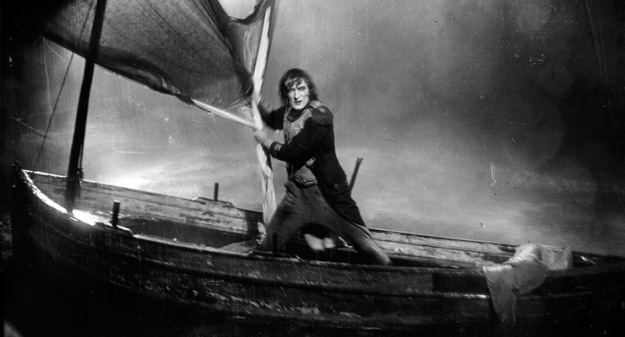 It truly is an extraordinary experience watching a silent film with live music. I have been lucky enough to see a film in this way three times, Buster Keaton’s Sherlock Jr with a decidedly non-authentic Jazz soundtrack, Harbour Drift at the London Film Festival 2013 and yesterday, Abel Gance’s Napoléon accompanied by the Philharmonia Orchestra at the Royal Festival Hall. The score for this third film was written over thirty years ago by Carl Davis and is widely considered to be the definitive classical score for the film. Hearing it live, it’s obvious why. Not only does the score hugely heighten the emotional impact of the film it is also masterfully synchronised to the visuals. Not a single cue is missed. If an instrument is on screen, you are hearing it. It even matches when the characters are singing the Marseillaise, as the orchestra swells into the chorus you see the crowds mouthing the chorus filmed a hundred years ago. It’s a bizarre sensation, to hear a piece of music completely in time with what was happening on the other side of the camera a century ago.
It truly is an extraordinary experience watching a silent film with live music. I have been lucky enough to see a film in this way three times, Buster Keaton’s Sherlock Jr with a decidedly non-authentic Jazz soundtrack, Harbour Drift at the London Film Festival 2013 and yesterday, Abel Gance’s Napoléon accompanied by the Philharmonia Orchestra at the Royal Festival Hall. The score for this third film was written over thirty years ago by Carl Davis and is widely considered to be the definitive classical score for the film. Hearing it live, it’s obvious why. Not only does the score hugely heighten the emotional impact of the film it is also masterfully synchronised to the visuals. Not a single cue is missed. If an instrument is on screen, you are hearing it. It even matches when the characters are singing the Marseillaise, as the orchestra swells into the chorus you see the crowds mouthing the chorus filmed a hundred years ago. It’s a bizarre sensation, to hear a piece of music completely in time with what was happening on the other side of the camera a century ago.
However, no matter how excellent the music it will always be overshadowed by the film it accompanies. Gance’s epic blurs the lines between history, fiction and documentary. Recreating some scenes almost exactly as they would have happened while in other places giving precedent to symbolism and emotion above historical fact. In 1927, the year when the ‘talkies’ burst onto screen Gance’s film represents a zenith in silent film production. When sound came in and anchored the camera to a static microphone it was work like Napoléon, the expressive and experimental side of cinema which suffered. The use of visual metaphor and motif is especially powerful, the sway of the ocean mirroring the sway of political opinion and an eagle representing Napoleon’s power. Throughout the film the cinematography and editing are incredibly modern. The film pioneered techniques such as splitscreen and and superimposition and these are used to fantastic effect but not overused. The freedom of the camera to go wherever the characters bodies, or indeed minds, go makes it an immersive piece of cinema. You truly feel the emotions of the characters and see the world through their eyes, not just physically through POV shots but emotionally. Panic and fear in fast cutting, cold in the blue tint and anger in the red.
There are a few places where the narrative drags but this is understandable in a five hour film, not every section will interest every viewer in a film which encompasses war, love, poverty, government and the lives of the aristocracy. Yet each and every section is rendered with the same detail and thorough mise-en-scene as every other. After an hour or so you can genuinely find yourself forgetting that you are watching a fiction, rather than the actual events. Albert Diudonné’s interpretation of Napoleon himself is captivating and deeply emotional. It brings humanity to the legend without trivialising or caricaturing the character of Napoleon. He holds the film almost single-handedly throughout. It is his burning passion that drives the action and holds the viewer’s sympathy regardless of any preconceived notions the viewer may have had.
The famous triptych sequence is truly a sight to behold. After so long watching a film in a tiny 4×3 box the world suddenly opens up as the film and the character of Napoleon reach their full potential. The triptych is not just a way of creating a widescreen effect, the images are duplicated and mirrored across the screens. The wide shots convey a huge sense of scale, but the real innovation is in the sequences projecting different images onto three screens. It’s an idea that was used by Gance in 1927 and then largely ignored for 100 years. He was doing then what James Franco’s As I Lay Dying is doing now, to at least equal effect. In the last couple of minutes the three screens take on a new significance as the left and right reels are tinted blue and red respectively. The film becomes a glowing tricolore instilling a sense of patriotism and joy that really captures the spirit of Napoleon’s legacy. In those final moments he becomes the cultural hero and you can’t help but admire the film, the man and the performance that has brought these images to you. It’s astonishing and completely breathtaking. Napoleon should not be judged as a film within its time, it should take its place alongside Gone With the Wind and Citizen Kane as a film where cinema took flight.
- Entertainment: 5/5
- Artistic: 5/5
- Intellectual: 5/5